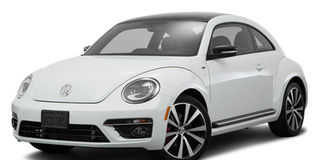The compact VW New Beetle

Volkswagen Beetle
What you need to know:
Unlike the original Beetle, the New Beetle has its engine in the front, driving the front wheels, with luggage storage in the rear. Combining classic styling and modern technologies, there is no mistaking the new Beetle. The sports styled bonnet and sharper roof line create a contemporary look that delivers real appeal
The Volkswagen Beetle has come a long way since its beginning as an affordable car for the German public. The original Beetle featured a rear-mounted engine powering the rear wheels. Engine displacement ranged from 1.1 to 1.6 litres depending on the year and spec. Volkswagen brought back the retro-inspired New Beetle for the 1999 model year. And it did look extremely desirable, a head turner so to speak. All the models after that looked virtually the same year after year. Nevertheless, the beetle is a cute car albeit having lost some of that head turning forte.
Exterior
First things first, does it still get the stares? Not so much. When the New Beetle was launched in 1998, it looked like anything else on the road besides the original Beetle, of course. It was adorable as a button and was quite popular during the first few years. The major problem when a manufacturer creates a retro car like this one; you have to redesign it at some point, but it still has to look like the original. The Beetle is a neat car, but its main asset is also its biggest problem. It will always look the way it looks. Only the most devoted fans will spot the differences, since every Beetle has the same profile.
According to volkswagen.com, an online portal, the panorama sliding/tilting glass roof in the Beetle covers the entire front area and fits elegantly into the roof. Tinted and insulated, it reflects 99 per cent of ultraviolet radiation and 92 per cent of heat, helping to prevent problems associated with glare and over-heating. At the touch of a button, the glass element can be tilted or partially or fully opened using the electrical lifting and sliding function. So you always have the choice between enjoying some fresh air or sheltering from the elements.
Interior
The interior space takes a hit for the Beetle style. It is cozy with good room for front-seat passengers, but limited rear-seat legroom. The seats are firm, well contoured, and comfortable for long trips. The instrument panel could not be simpler, with one giant gauge housing the speedometer, tachometer and fuel gauge in unison. That said, the interior panels and dash are cheap. Plastic interior components scratch and crack easily after the several years of heat bashing.
Engine and handling
The Beetle shares the same platform strategy as the Golf of the time which gives it an excellent foundation. The firm suspension limit body lean during cornering striking an excellent balance between ride compliance and handling. The car feels solid, controlled, and responsive, whether on the highway or in town. VW provided a range of engines with this car but the most common is the 1.8L and 2.0L mated to a 4 speed automatic. Manuals are available with models from Europe and so are the diesels.
Value
Resale value is terrible and maintenance shall be a nightmare as spare parts for specifically non service parts are not that available. The car shares some parts with the Golf so that might be some light at the end of the tunnel. If you really want this car for the looks, you are not alone as it’s cute as they get. I wouldn’t recommend it simply on grounds of abysmal resale value and the headache that comes with maintenance.
Safety first
According to volkswagen.com, an online portal, the Beetle has thought of everything where safety is concerned: the standard Electronic Stabilisation Programme (ESP) ensures excellent handling characteristics even in difficult situations. By intervening in the braking system and engine management with lightning speed, the system helps the Beetle to stay on course with masterful ease. Another feature is the hill hold control - it governs the starting torque when pulling away on an uphill gradient and interacts with the hydraulic brake assist and the transmission control to prevent the vehicle from rolling backwards by applying the brakes.




